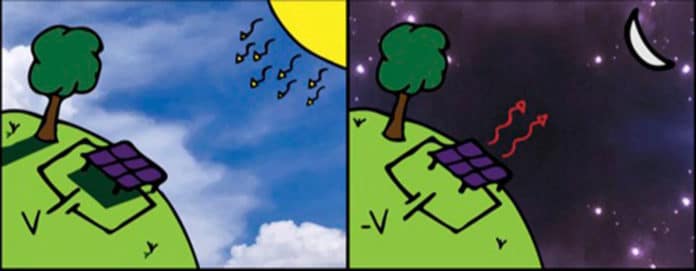Photovoltaics have critical potential because of the abundance of solar power occurrences on earth; however, they can create power during sunlight hours.
What if solar cells worked at night?
This idea led scientists to create a new approach that uses the earth as a heat source and the night sky as a heat sink, resulting in a ‘night-time photovoltaic cell.’
To produce electrical power after the sun has set, scientists from the University of California – Davis, consider an alternative photovoltaic concept- night-time solar cells- that could generate up to 50 watts of power per square meter under ideal conditions at night, about a quarter of what a conventional solar panel can generate in the daytime.
Jeremy Munday, a professor in the Department of Electrical and Computer Engineering at UC Davis, said, “The process is similar to the way a normal solar cell works but in reverse. An object that is hot compared to its surroundings will radiate heat as infrared light. A conventional solar cell is cool compared to the sun, so it absorbs light.”
“Space is cold, so if you have a warm object and point it at the sky, it will radiate heat toward it. People have been using this phenomenon for night-time cooling for hundreds of years. In the last five years, there has been a lot of interest in devices that can do this during the daytime (by filtering out sunlight or pointing away from the sun).”
“There’s another kind of device called a thermoradiative cell that generates power by radiating heat to its surroundings. We used them for our exploration to capture waste heat from engines.”
“We were thinking, what if we took one of these devices and put it in a warm area and pointed it at the sky. This thermoradiative cell pointed at the night sky would emit infrared light because it is warmer than outer space.”
“A regular solar cell generates power by absorbing sunlight, which causes a voltage to appear across the device and for current to flow. In these new devices, light is instead emitted, and the current and voltage go in the opposite direction, but you still generate power. You have to use different materials, but the physics is the same.”
Interestingly, these night-time solar cells could work during the day as well if you took steps to either block direct sunlight or point it away from the sun. Because this new type of solar cell could potentially operate around the clock, it is an intriguing option to balance the power grid over the day-night cycle.
Journal Reference
- Tristan Deppe and Jeremy N. Munday; Nighttime Photovoltaic Cells: Electrical Power Generation by Optically Coupling with Deep Space. ACS Photonics 2020, 7, 1, 1–9 DOI: 10.1021/acsphotonics.9b00679
